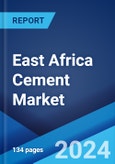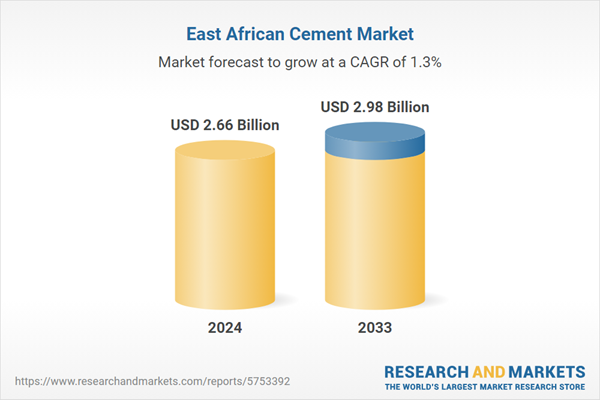The East Africa cement market size reached USD 2.66 billion in 2024. Looking forward, the research expects the market to reach USD 2.98 billion by 2033, exhibiting a growth rate (CAGR) of 1.3% during 2025-2033. The increasing infrastructural development, the introduction of major housing projects, and the increasing number of people moving from rural areas to cities due to rapid urbanization are among the key factors driving the market growth.
Cement is a crucial binding agent used in construction and engineering applications. It is a fine powder made from a mixture of materials, primarily limestone, clay, shells, and silica sand. The production of cement involves a process called calcination, where these raw materials are heated to high temperatures in a kiln. This process causes chemical reactions that transform the raw materials into a new compound called clinker. Cement is valued for its ability to provide strength, durability, and stability to structures. It is an essential component in the construction industry, enabling the creation of solid and long-lasting buildings and infrastructure.
The market is primarily driven by the increasing constriction activities across the region. Governments are investing in the construction of roads, bridges, ports, airports, railways, and other infrastructure projects. These projects drive the demand for cement as it is a primary building material, stimulating the growth of the cement market. In addition, East Africa has one of the fastest-growing populations in the world. With a growing population, there is a need for additional infrastructure, including housing, schools, hospitals, and other public facilities.
Cement is a vital component in these construction projects, leading to increased demand for cement in the region. Besides, the region is striving to industrialize and diversify its economy. As the manufacturing sector expands, there is a growing need for cement for construction of factories, warehouses, and industrial infrastructure. As a result, the growth of industries such as textiles, food processing, and manufacturing is escalating the demand for cement.
East Africa Cement Market Trends/Drivers:
The increasing infrastructural development
Infrastructural development projects, such as the construction of roads, bridges, ports, airports, and railways, require substantial amounts of cement. As a primary building material, cement is in high demand for these infrastructure projects. The increased investment in infrastructure drives the growth of the cement market in East Africa. Moreover, infrastructure development often involves cross-border projects and regional integration efforts. In East Africa, initiatives such as the construction of cross-border roads, railways, and energy networks require significant cement supplies.
This drives the demand for cement in the region and fosters collaboration among countries, further boosting the East Africa cement market. Besides, with a focus on green building and eco-friendly infrastructure, there is a growing demand for environment-friendly cement products such as blended cement or low-carbon cement. This shift toward sustainable development influences the types of cement demanded in the market.
Rapid Urbanization
Urbanization leads to a surge in population in cities, creating a higher demand for housing. As more people are migrating from rural areas to urban centers, the need for residential buildings, apartments, and housing complexes is increasing in the region. Hence, the rapid urbanization in East Africa leads to an increased investment in infrastructure development, consequently driving the demand for cement in the market. Moreover, office buildings, shopping centers, hotels, and industrial complexes are being constructed to cater to the expanding urban economy.
Cement is an essential material in these construction projects, contributing to the growth of the cement market in East Africa. Besides, as urban areas are expanding, there is also a need to modernize and upgrade existing infrastructure and buildings to accommodate the growing population and changing needs. This includes renovation, expansion, and redevelopment projects that require cement.
East Africa Cement Industry Segmentation:
The research provides an analysis of the key trends in each segment of the East Africa cement market report, along with forecasts at the regional and country levels from 2025-2033. Our report has categorized the market based on type and application.
Breakup by Type:
- Portland
- Blended
- Other.
Portland cement represents the most popular product type
The report has provided a detailed breakup and analysis of the market based on the type. This includes Portland, blended, and others. According to the report, Portland cement represented the largest segment.
Portland cement is highly versatile and can be used in a wide range of construction applications. It is suitable for both residential and commercial projects, including building foundations, walls, floors, bridges, roads, and other infrastructure. Its versatility and compatibility with various construction materials make it the preferred choice for many construction projects.
Moreover, it offers excellent strength and durability properties, making it suitable for long-lasting structures. It also provides the necessary compressive strength to support heavy loads and withstand environmental stresses, such as temperature changes and moisture. The durability of structures built with Portland cement is contributing to its widespread use.
Besides, Portland cement is produced in large quantities and is readily available in the market. Cement manufacturers have well-established production processes and distribution networks, ensuring a consistent supply of Portland cement to meet the construction industry's demands. Its widespread availability makes it the default choice for many construction projects.
Breakup by Application:
- Residential
- Commercial
- Infrastructural
Residential applications account for the majority of the market share
A detailed breakup and analysis of the market based on the application has also been provided in the report. This includes residential, commercial, and infrastructure. According to the report, the residential segment accounted for the largest market share.
The demand for housing is consistently high due to population growth, urbanization, and changing demographics. Residential construction projects, including houses, apartments, and housing complexes, require significant amounts of cement. The need for adequate and affordable housing drives the demand for cement in the residential sector, making it a dominant market segment.
Residential construction projects tend to have a higher volume compared to other sectors such as commercial or infrastructure projects. The number of residential units being built often surpasses the number of commercial buildings or infrastructure projects. Consequently, the sheer volume of residential construction contributes to residential applications accounting for a substantial portion of the cement market.
Breakup by Region:
- Ethiopia
- Kenya
- Tanzania
- Uganda
- Sudan
- Rwanda
- Others
The report has also provided a comprehensive analysis of all the major regional markets, which include Ethiopia, Kenya, Tanzania, Uganda, Sudan, Rwanda, and Others.
Competitive Landscape:
The competitive landscape of the market is characterized by the presence of both local and international players. At present, key players are investing in new cement plants, expanding existing facilities, or acquiring other cement companies. They are also diversifying their product offerings to cater to a wider range of customer needs. This includes introducing blended cement products, such as Portland Pozzolana Cement (PPC) or composite cement, which offer improved sustainability, enhanced performance, or reduced environmental impact.
Moreover, the leading players are investing in research and development to enhance cement formulations, improve manufacturing processes, and introduce innovative products. This includes developing specialized cement for specific applications, such as high-strength cement, self-healing cement, or cement with low carbon emissions. Providing high-quality, innovative solutions helps cement manufacturers attract customers and maintain a competitive advantage.
The report has provided a comprehensive analysis of the competitive landscape in the market. Some of the detailed profiles of the companies covered in the report include:
- Bamburi Cement Limited
- ARM Cement PLC
- East African Portland Cement PLC (EAPC)
- Dangote Cement Plc
- Mombasa Cement Limited.
Key Questions Answered in This Report
- What was the size of the East Africa cement market in 2024?
- What is the expected growth rate of the East Africa cement market during 2025-2033?
- What are the key factors driving the East Africa cement market?
- What has been the impact of COVID-19 on the East Africa cement market?
- What is the breakup of the East Africa cement market based on the type?
- What is the breakup of the East Africa cement market based on the application?
- What are the key regions in the East Africa cement market?
- Who are the key players/companies in the East Africa cement market?
Table of Contents
Companies Mentioned
- Bamburi Cement Limited
- ARM Cement PLC
- East African Portland Cement PLC (EAPC)
- Dangote Cement Plc
- Mombasa Cement Limited
Table Information
| Report Attribute | Details |
|---|---|
| No. of Pages | 139 |
| Published | June 2025 |
| Forecast Period | 2024 - 2033 |
| Estimated Market Value ( USD | $ 2.66 Billion |
| Forecasted Market Value ( USD | $ 2.98 Billion |
| Compound Annual Growth Rate | 1.3% |
| Regions Covered | Africa |
| No. of Companies Mentioned | 5 |









